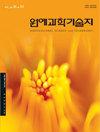Analysis of Predictions of Garlic Bulb Weight using LASSO Regression Model
IF 0.8
4区 农林科学
Q3 HORTICULTURE
Korean Journal of Horticultural Science & Technology
Pub Date : 2023-08-31
DOI:10.7235/hort.20230040
引用次数: 0
Abstract
As part of a preemptive response to ensure a stable supply and demand policy for garlic (Allium sativum L.), the Korean government strives to determine the final yield of garlic by observing its growth status by season. In particular, estimation of the bulb weight of garlic is one of the main steps in estimating garlic production, conducting observational work on spherical weight prediction is getting more important is getting more important. The observation data on garlic can be viewed as data for predicting the final weight, but since root growth occurs intensively at a specific time, there is a limit to predicting the final bulb weight only by the bulb weight corresponding to each observation time point. In addition, since the factors affecting the final bulb weight of garlic may be different for each growing stage, an estimation is required for each stage to predict the final bulb weight at each time point. In this study, garlic bulb weight estimation analysis, which reflects the characteristics of Korean garlic grown in an outfield, is performed using growth survey data. A stage-by-stage model for predicting the bulb weight of garlic at each time point is established, based on the fact that the factors influencing the bulb weight of garlic may differ according to the growth stage. In the process, LASSO regression is used for variable selection and coefficient estimation of the bulb weight of garlic. As a result of the estimation, significant factors regarding growth, lot and environment were identified stage by stage, providing indicators for forecasting final bulb weight of garlic at each stage.大蒜鳞茎质量LASSO回归模型预测分析
为了确保大蒜(Allium sativum L.)的稳定供需政策,韩国政府正在努力通过观察大蒜的生长情况,确定大蒜的最终产量。特别是大蒜球茎质量的估计是大蒜产量估计的主要步骤之一,进行球茎质量预测的观测工作变得越来越重要。大蒜的观测数据可以作为预测最终重量的数据,但由于根生长集中在特定时间,因此仅通过每个观测时间点对应的鳞茎重量来预测最终鳞茎重量是有局限性的。此外,由于影响大蒜最终鳞茎重的因素在每个生长期可能不同,因此需要对每个生长期进行估计,以预测每个时间点的最终鳞茎重。在本研究中,大蒜鳞茎重量估计分析,反映了韩国大蒜生长在外场的特点,使用生长调查数据进行。根据大蒜生长阶段不同,影响大蒜鳞茎质量的因素不同,建立了各时间点大蒜鳞茎质量的分阶段预测模型。在此过程中,采用LASSO回归进行大蒜鳞茎质量的变量选择和系数估计。通过估算,分阶段确定了生长、地段、环境等方面的显著因子,为预测各阶段大蒜最终鳞茎重提供了指标。
本文章由计算机程序翻译,如有差异,请以英文原文为准。
求助全文
约1分钟内获得全文
求助全文
来源期刊
CiteScore
2.00
自引率
0.00%
发文量
0
审稿时长
1 months
期刊介绍:
Horticultural Science and Technology (abbr. Hortic. Sci. Technol., herein ‘HST’; ISSN, 1226-8763), one of the two official journals of the Korean Society for Horticultural Science (KSHS), was launched in 1998 to provides scientific and professional publication on technology and sciences of horticultural area. As an international journal, HST is published in English and Korean, bimonthly on the last day of even number months, and indexed in ‘SCIE’, ‘SCOPUS’ and ‘CABI’. The HST is devoted for the publication of technical and academic papers and review articles on such arears as cultivation physiology, protected horticulture, postharvest technology, genetics and breeding, tissue culture and biotechnology, and other related to vegetables, fruit, ornamental, and herbal plants.

 求助内容:
求助内容: 应助结果提醒方式:
应助结果提醒方式:


